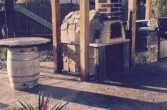Home Is Where the Concrete Is!
 Published October 30 2015
Published October 30 2015
Did you ever notice the nicest homes in the neighborhood are the ones that are highlighted with decorative concrete? A home’s value and aesthetics can be greatly improved by designing it to have durable, attractive features added to enhance the architecture of the structure. Decorative concrete is the fastest growing segment of the concrete industry, and people all over the country are learning what a valuable addition even a small accent can make.
My wife and I built a modest home in a new subdivision a few years ago. We wanted to make an aesthetical, decorative difference, but had a fairly tight budget. Looking at the other homes on the street, they all had one common theme: A plain concrete patio; a plain concrete driveway; and a plain concrete front porch. We hired an expert at colored, stamped concrete to create something different. We went with integral colored concrete and used a contrasting earth tone color highlight. The decorative contractor enlarged the back patio from 10’ x 14’ to 10’ x 24’ to allow for a future hot tub or more entertaining space. The extra investment was around $5,000. However, the appraised value on this house is now well over $25,000 higher than the neighbors’. Therefore, it was a wise investment.
The garage standards of today have changed dramatically in recent years. Today, almost every new home has a 3-car garage with every kind of organizational device imaginable to make the space a show place. Adding a SPARTACOTE™ resinous floor coating to complete the look is money well spent. Check out the decorative flooring design possibilities that can be done in the garage, rec room or Four Seasons rooms. The design potential is unlimited.
Finished basements offer a low cost way to add more square footage to a home. Consider having your foundation walls poured with the use of decorative form liners. With very low additional cost, concrete forms can have liners added to them that create the look of brick, stone or stacked stone. If the wall contractor uses L&M DEBOND GOLD™ to treat the forms, you will receive a wall nearly 100% free of bug holes or unsightly defects.
After the home is completed, the stone or brick look can be dyed or shaded using L&M VIVID DYE WB PLUS™ locked-in and protected with LUMISEAL FX™ decorative sealer. This produces an aesthetically pleasing, durable, washable wall with an attractive color.
To complete that lower level living space, consider a polished concrete floor, especially if you have a walk-out basement. Installing LATICRETE FLOOR HEAT and then using the FGS PERMASHINE™ polished concrete system colored with VIVID DYE™ creates a living space that is warm and inviting to family and guests.
Here are some things you should discuss with your homebuilder before construction begins in order to avoid problems arising later. Treat this list like a checklist and give them a copy. All too often, homeowners will reach out to our technical services department with issues of cracks, poor sealer performance, staining and scaling of outdoor flatwork.
Avoid problems before they happen…
Exterior concrete: Whether stamped or broom finished, make sure your concrete contractor applies a good quality cure & seal, such as L&M DRESS & SEAL™ and DRESS & SEAL WB™, immediately after final finishing is completed. The exception to this rule is for concrete poured and placed in northern freeze / thaw areas after October 15th. Then, the installer should use insulated blankets for 7 days after the pour. When removed and allowed to air dry, the concrete will then have a chance to de-water and prevent scaling. Once dry, apply L&M AQUAPEL™ to the surface and your fear of scaling will go away.
Crack prevention: Concrete cracks for several preventable reasons, most of which can be avoided. First, make sure the sub-grade has plenty of gravel placed and properly compacted prior to placing the concrete. This provides good drainage and a sound foundation for the concrete. Next, make sure the contractor properly places saw cuts, called control joints, at the proper spacing as specified by the American Concrete Institute.
The weather plays an important role in a successful placement. Concrete requires suitable conditions created either by Mother Nature or by the contractor. The rule of thumb is, “if you are comfortable, the concrete is comfortable” (meaning temperatures). Make sure this is discussed in a pre-pour meeting with your contractor.
Concrete sealers are highly effective in keeping your concrete looking and performing well for years. As mentioned earlier, AQUAPEL™ is best for exterior concrete as well as garage floors not receiving a SPARTACOTE™ polyaspartic coating. AQUAPEL™ protects concrete from water and salt damage dragged in by your vehicles. Treat patios and stamped concrete with LUMISEAL PLUS™ or LUMISEAL WB PLUS™, both easily applied by roller. Do not over apply these decorative sealers—more is not better. One or two thin coats are better than one thick, heavy coat. Think, “Thin to Win.”
Whatever you decide to do with your residential concrete plan, LATICRETE concrete professionals are here to help with suggestions, methods and products. You can locate a technical service representative in your area at: http://www.lmcc.com/contact-distributors.asp.
About the Author:
Bill Butler is a technical service rep for LATICRETE International. He has sold and provided expertise in concrete ready mix trucks, admixtures, and construction products since 1976. His approach to helping contractors and installers “do things right the first time” or when necessary, “do things right the second time” is to ask good questions, be thorough, and learn from mistakes instead of repeating them.
Phone: 920-450-2932
Email: wlbutler@laticrete.com